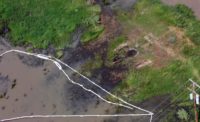Environment
The meticulous cleanup of Montana's Yellowstone River continues following a July 1 ExxonMobil oil pipeline rupture that spewed 1,000 barrels of crude oil into the flooding river at the pipe's Silvertip crossing near Laurel, Mont.
Bob Perciasepe, Environmental Protection Agency deputy administrator, told a U.S. Senate Environment and Public Works subcommittee on July 21 that 755 personnel on site included 610 people “currently in the field engaged in cleanup and sampling.”
Exxon spokeswoman Rachel Moore says crews have deployed 57,000 ft of boom and about 277,000 absorbent pads to help sop up the oil. More than 60 private contractors—ranging from security to cleanup specialists—and 14 public agencies are working as a unified response team, says Craig Myers, EPA's on-scene coordinator.
The area downriver of the spill is divided into four zones. Cleanup is concentrated in the first two sections, totaling 19 miles. Further evaluation stretches another 222 miles. “Deployment will continue to focus on the highest-priority areas,” Moore says.
Perciasepe said that, so far, crews have removed 942 barrels of “oily liquids” and 505 cu yd of “oily solids” from the site. However, he wasn't sure how much more cleanup is needed. The cause of the rupture is still unknown as crews have yet to reach the submerged pipe, said Cynthia Quarterman, administrator of the U.S. Pipeline and Hazardous Materials Safety Administration, at the Senate hearing. She said investigators will scrutinize the pipe, which may have been severed by the rushing river, running nearly a foot above flood stage. According to U.S. Geological Survey data, the flow rate was about 35,000 cu ft per second on July 1, up from the 86-year median rate of about 1,200 cfs.
The EPA holds Exxon fully accountable for the cleanup costs, but Moore says it is too early to estimate the price tag.



Post a comment to this article
Report Abusive Comment